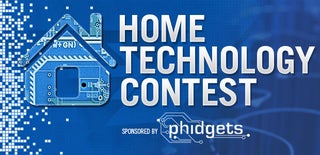Introduction: Home Automation
My home automation is built using Phidgets and Xbee radio's. The software is written in c# in .net
From the touchscreen panel I am able to:
- control the heating or cooling modes on the HVAC system
- Open and close my garage doors as well as tell the state of the door.
- See the humidity level of my house
- Tell the difference between the floor temperatures in my house
- Determine the overall power consumption by phase and the cost
- see the outside temp and forecast
- Shared google calendar
- Watch the video feeds from my driveway and front door cameras
- set the home and away temperatures.
I can also control most of these functions from my mobile web interface
Step 1: What You Will Need to Purchase
Items from Phidgets
- 1018_2 - PhidgetInterfaceKit 8/8/8
- 3503_0 - i-Snail-VC-100 AC Current Sensor 100Amp QTY:2
1125_0 - Humidity/Temperature Sensor QTY: As many as you wish to monitor
3109_0 - TPK-01G Bead Probe K-type Thermocouple (-50°C to +450°C) QTY: As many as you wish to monitor
1051_2 - PhidgetTemperatureSensor 1-Input QTY: As many as you wish to monitor
3052_1 - SSR Relay Board 2.5A QTY: 3 for HVAC, more to turn on lights etc..
Optional Wireless modules:
- XBee series 1 configured for IO line passing mode
Computer:
I am using a windows based machine for my software to run, you could use linux or something else since the phidgets products work with pretty much anything.
Step 2: HVAC Details
Since the only thing really consistent to others for this project will be the hardware and HVAC I will focus on that for the how to
You will want to know how to turn on and off your HVAC and in the different modes.
I made sure i could get this working first just using some wire
Turn on Fan:
Bridge : G to Common
Turn on A/C
Bridge : G to Common
Bridge: Y to Common
Important you do not want to join G and Y together just use separate wires down to Common
Turn on Heating:
Bridge : G to Common Bridge: Y to Common Important you do not want to join G and Y together just use separate wires down to Common
Link to wiring details http://wiki.xtronics.com/index.php/Thermostat_sign...
Step 3: Connect Your Outputs
- Plug all the Phidgets sensors into the interface board.
- Connect all the relay boards to the digital outputs
- You will want to connect the + lead to the output and the - lead down to ground
- plug the analog sensors into the analog inputs
Step 4: Test You Hardware
Testing is important because its possible to have a bad output or input and drive yourself crazy.
Testing:
- Plug you phidgets IO board into a PC and install the phidgets drivers
http://www.phidgets.com/docs/Operating_System_Supp...
- Make sure that the divers install correctly and double click on the phidgets control center icon in the task bar
- Test the I/O board
- Go through each of the outputs turning them on and off , measure the output with a volt meter should register around 5v
- Check the relay board you should have a direct short when the output is on and it should be open when the output is off.
- Open the temp util and check the temperatures
- You can get the detailed procedure on everything from the product page of the phidgets site
Step 5: Connecting the HVAC
Turn on Fan:
- Connect the relay output one end should get connected to the G from your HVAC and the other should be connected to your C or common
Turn on A/C Bridge :
- Connect the relay output one end should get connected to the Y from your HVAC and the other should be connected to your C or common
Turn on heat:
- Connect the relay output one end should get connected to the W from your HVAC and the other should be connected to your C or common
Important - You will always need to turn on your fan first then the mode you want to start up
*****Very Important never turn on heating and cooling at the same time.
Link to wiring details http://wiki.xtronics.com/index.php/Thermostat_sig...

Participated in the
Home Technology Contest









